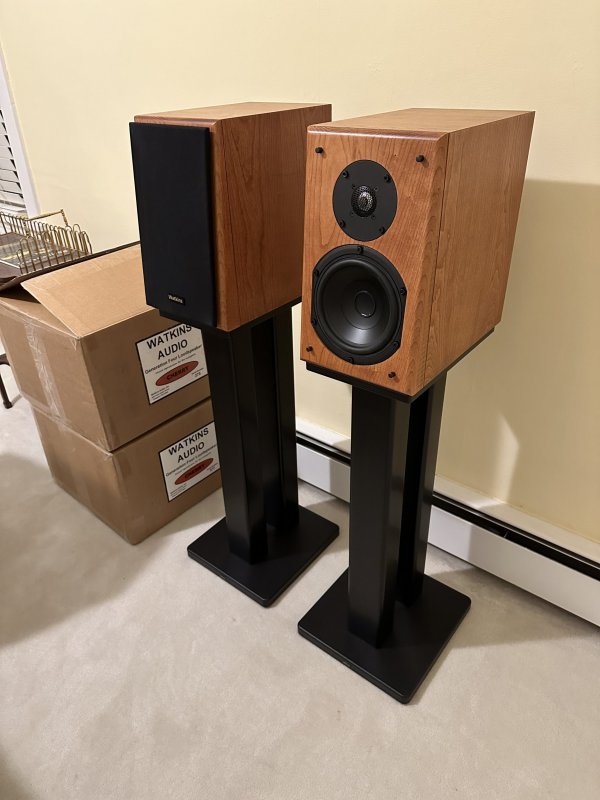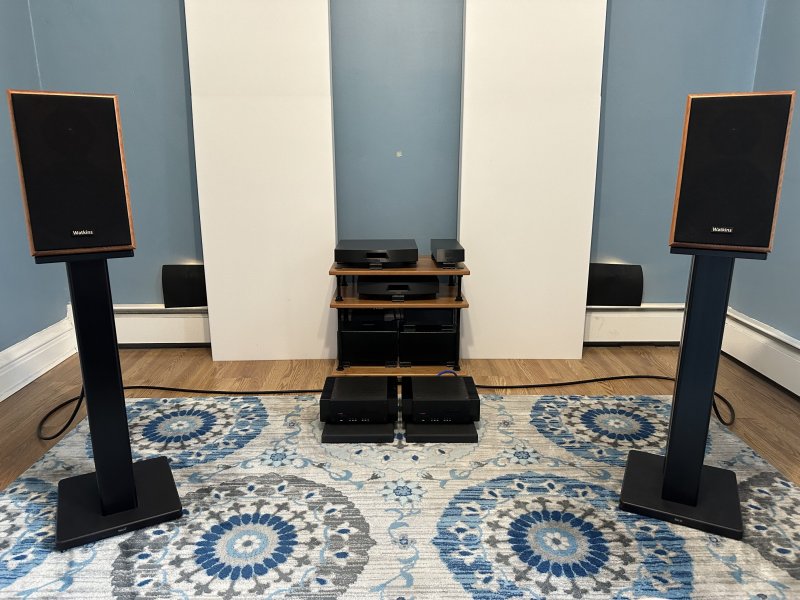The Watkins brand is hardly a well-known name in high-end audio circles. This family-run company has been around for about 60 years, though, with first Bill Watkins Sr., and now his son, Bill Watkins Jr., running the operation. A short interview with Bill Watkins Jr. can be found here. Bill Jr. published a book in 2022 titled "Loudspeaker Physics and Forced Vibration."
And, confession time: The only reason I bought the Graham LS8/1 was that when I wanted to move on from the Sanders 10e for various reasons, these Watkins speakers were not then available. The Watkins Generation 4 was out of production with no stock available for about two years. After REG reviewed the Graham LS8/1 I bought the Grahams since I thought they also had great potential and I certainly was not wrong about that. But I stayed on the waiting list for the Watkins, waiting for production to resume and for the entire time I’ve owned the Grahams.
Like many small businesses, Bill Watkins’ former woodworker (who produced the Gen 4 cabinets to Watkins’ specs) went out of business near the beginning of the pandemic. It took Bill a LONG time to find another woodworker willing and able to make the rather complicated cabinets to Bill’s satisfaction at a price which would enable Bill to sell the speakers for a price he believes his market would tolerate. As it is, the price went from $2,500 a pair to now $3,000 a pair with the new woodworker. Bill told me these new cabinets are the best he’s ever offered in terms of fit and finish.
My fascination with the Watkins Generation 4 developed because I saw it as the ultimate refinement of the old EPI 100/Epicure 10 two-way module developed in the early 1970s by Winslow Burhoe. I have long admired those speakers. While the top octaves were a bit or more bright sounding when listened to on axis (see Julian Hirsh’s test report here), when arranged so that the speakers face each other and listened to at right angles to the baffle, those speakers were remarkably refined and hugely open sounding for their time and even today. They were a simple sealed two-way box speaker with a minimal first-order analog crossover (a single capacitor to roll off the bottom-end response of the tweeter) with bass extension down to 40 Hz or so. The Watkins Generation 4 takes this minimal first-order crossover concept and adds physical time alignment via a sloping baffle and premium parts to this formula. It also has a custom-damped tweeter and the famous Watkins woofer alignment which is ported but rolls off at 18 dB/octave rather than the usual 24 dB/octave of a ported woofer or 12 dB/octave like a sealed cabinet. The big Infinity speakers that HP liked back in the day used Watkins woofers.
I was also fascinated since one of my early audio heroes, J. Gordon Holt, founder of Stereophile, used a predecessor of the Generation 4, the enormous Watkins WE-1, designed by Bill Watkins Sr., as his reference speakers for several years back in the 1980s, an eternity in high-end speaker advancements. Most listeners, as well as Bill Watkins Jr. himself, believe that in most ways the Generation 4, despite its relatively diminutive size, is by far a better speaker than the old WE-1.
My fascination was also piqued by Dick Olsher’s review of the Generation 4 in The Absolute Sound in 2017. To my knowledge, that’s the only “serious” review of the Generation 4 speakers, even though, yes, the Generation 4 has been around for a few years now. Some changes to the design were made after Olsher’s review. See the manufacturer’s discussion of the updates here.
The walks-on-water testimonials from owners of the Generation 4 further piqued my interest despite the lack of other reviews by the audiophile press.
I should also confess that when I first received the Generation 4 speakers, I was reluctant to set them up. The Graham LS8/1 were sounding so very wonderful with the recent addition of Lumin L2 and fiber optic networking to my system. The Watkins speakers sat in their unopened boxes for about a week. When I finally got around to unboxing them, I set them atop the Skylan 30-inch-tall SP-30 two-post stands (with posts filled with wood pellets) which I months before had purchased and set up in anticipation of finally acquiring the Watkins speakers. There they sat for another week, still unauditioned.

And, confession time: The only reason I bought the Graham LS8/1 was that when I wanted to move on from the Sanders 10e for various reasons, these Watkins speakers were not then available. The Watkins Generation 4 was out of production with no stock available for about two years. After REG reviewed the Graham LS8/1 I bought the Grahams since I thought they also had great potential and I certainly was not wrong about that. But I stayed on the waiting list for the Watkins, waiting for production to resume and for the entire time I’ve owned the Grahams.
Like many small businesses, Bill Watkins’ former woodworker (who produced the Gen 4 cabinets to Watkins’ specs) went out of business near the beginning of the pandemic. It took Bill a LONG time to find another woodworker willing and able to make the rather complicated cabinets to Bill’s satisfaction at a price which would enable Bill to sell the speakers for a price he believes his market would tolerate. As it is, the price went from $2,500 a pair to now $3,000 a pair with the new woodworker. Bill told me these new cabinets are the best he’s ever offered in terms of fit and finish.
My fascination with the Watkins Generation 4 developed because I saw it as the ultimate refinement of the old EPI 100/Epicure 10 two-way module developed in the early 1970s by Winslow Burhoe. I have long admired those speakers. While the top octaves were a bit or more bright sounding when listened to on axis (see Julian Hirsh’s test report here), when arranged so that the speakers face each other and listened to at right angles to the baffle, those speakers were remarkably refined and hugely open sounding for their time and even today. They were a simple sealed two-way box speaker with a minimal first-order analog crossover (a single capacitor to roll off the bottom-end response of the tweeter) with bass extension down to 40 Hz or so. The Watkins Generation 4 takes this minimal first-order crossover concept and adds physical time alignment via a sloping baffle and premium parts to this formula. It also has a custom-damped tweeter and the famous Watkins woofer alignment which is ported but rolls off at 18 dB/octave rather than the usual 24 dB/octave of a ported woofer or 12 dB/octave like a sealed cabinet. The big Infinity speakers that HP liked back in the day used Watkins woofers.
I was also fascinated since one of my early audio heroes, J. Gordon Holt, founder of Stereophile, used a predecessor of the Generation 4, the enormous Watkins WE-1, designed by Bill Watkins Sr., as his reference speakers for several years back in the 1980s, an eternity in high-end speaker advancements. Most listeners, as well as Bill Watkins Jr. himself, believe that in most ways the Generation 4, despite its relatively diminutive size, is by far a better speaker than the old WE-1.
My fascination was also piqued by Dick Olsher’s review of the Generation 4 in The Absolute Sound in 2017. To my knowledge, that’s the only “serious” review of the Generation 4 speakers, even though, yes, the Generation 4 has been around for a few years now. Some changes to the design were made after Olsher’s review. See the manufacturer’s discussion of the updates here.
The walks-on-water testimonials from owners of the Generation 4 further piqued my interest despite the lack of other reviews by the audiophile press.
I should also confess that when I first received the Generation 4 speakers, I was reluctant to set them up. The Graham LS8/1 were sounding so very wonderful with the recent addition of Lumin L2 and fiber optic networking to my system. The Watkins speakers sat in their unopened boxes for about a week. When I finally got around to unboxing them, I set them atop the Skylan 30-inch-tall SP-30 two-post stands (with posts filled with wood pellets) which I months before had purchased and set up in anticipation of finally acquiring the Watkins speakers. There they sat for another week, still unauditioned.

Last edited:


